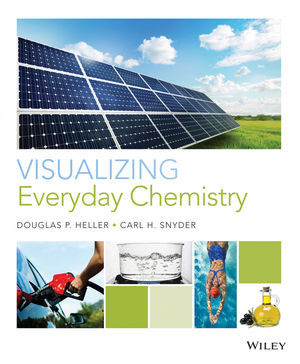
Visualizing Everyday Chemistry
By Douglas P. Heller, Carl H. Snyder
Visualizing Everyday Chemistry shows students what chemistry is and what it does, by integrating words with powerful and compelling visuals and learning aids. With this approach, students not only learn the basic principles of chemistry but see how chemistry impacts their lives and society.
This innovative new course solution for the liberal arts chemistry course engages non-science majors through visual pedagogy, real world examples, and video demonstrations while expanding class interactivity and improving student outcomes in WileyPLUS Learning Space.
Schedule a Demo Sign Up for a Test Drive Adopt WileyPLUSWant to learn more about WileyPLUS? Click Here
Learning Objectives
Located at the start of each major section, a list in behavioral terms presents the concepts that students are expected to master while studying the section.
Process Diagrams
These diagrams integrate visuals and text to describe a complex process. Students can follow a process and see the change in the parts of the figure.
What a Chemist Sees
These high-interest features show students how to “think like a chemist” and develop observational skills.
Chemistry InSight
Using a combination of photos, diagrams, and data, these multi-part visual sections focus on a key concept or topic in the chapter, exploring it in detail or showing how it plays out in different applications.
In Words, Math, and Pictures
These multi-part visual sections guide students through quantitative concepts, such as exponential notation, unit conversions, pH, and the mole.
Experiencing Everyday Chemistry
Icons within the text alert students to tie-in video demonstrations available in WileyPLUS. Supplementary instructor guides help make in-class demonstrations using everyday items a natural part of teaching.
Exercises
Within each chapter, student questions appear at the ends of sections, with selected figures, and after selected topics known to pose some problems for students.
Did You Know?
Integrated with the chapter presentation, these essays focus on interesting developments in contemporary chemistry and invite students to think critically about them.
- Chemistry is not an abstract field of learning, but has practical, everyday applications that are important to all of us.
- Chemistry addresses a growing number of environmental concerns, from energy and resource consumption to pollution.
- A risk/benefit perspective on the role of chemistry in society and in our personal lives is central to developing informed opinions on policy and making better consumer choices.
- Learning Objectives: Located at the start of each major section, a list in behavioral terms presents the concepts that students are expected to master while studying the section.
- Process Diagrams: These features integrate visuals and text to describe a complex process, such as the carbon cycle and acid rain formation. Students can follow a process and see the change in the parts of the figure. This approach unburdens the text and lets the images tell the story.
- What a Chemist Sees: These high-interest features illustrate a concept that means one thing to the consumer and another to the scientist. They show students how to “think like a chemist” and develop observational skills.
- Chemistry InSight: Using a combination of photos, diagrams, and data these multipart visual sections focus on a key concept or topic in the chapter, exploring it in detail or showing how it plays out in several different applications.
- In Words, Math, and Pictures: These multipart visual sections guide students through quantitative concepts, such as exponential notation, unit conversions, pH, and the mole.
- Experiencing Everyday Chemistry: Icons at points within the text alert students to tie-in video demonstrations available in WileyPLUS Learning Space. Supplementary instructor guides help make in-class demonstrations (using everyday items) a natural part of teaching the course.
- Exercises: Within each chapter, student questions appear at the ends of sections (Concept Checks), with selected figures (short-answer questions), and after selected topics known to pose some problems for students, such as unit conversions and compound names and formulas (Know Before You Go).
- Did You Know?: Integrated with the chapter presentation, these essays focus on interesting developments in contemporary chemistry, from forensic science to biofuels to designer macronutrients and invite students to think critically about them.
What’s New
Powerful visuals are used to teach the concepts of chemistry. In Visualizing Everyday Chemistry, visuals are not just decorative; they present facts, concepts, processes, principles, and relationships.
Three themes are woven throughout the text:
The following features are included in Visualizing Everyday Chemistry to facilitate students’ mastery of the material:
WileyPLUS Learning Space is an easy way for students to learn, collaborate, and grow. With WileyPLUS Learning Space, students create a personalized study plan, assess progress along the way, and make deeper connections as they interact with the course material and each other.
Through a combination of dynamic course materials and visual reports, this collaborative learning environment gives you and your students immediate insight into strengths and problem areas in order to act on what’s most important.

DOUGLAS HELLER
Douglas Heller received his Ph.D. in Organic Chemistry and MBA, both from the University of Chicago. He has worked in the field of technology transfer, helping to commercialize biomedical and physical science discoveries, and in the pharmaceutical industry, in project management and corporate communications. He then moved to academia with a visiting appointment in forensic science. Since 2005, he has been at the University of Miami, where he teaches organic chemistry, chemistry for non-science students, and an innovative honor’s general chemistry sequence integrating biology and calculus. In conjunction with the university’s Writing Center, he also mentors science graduate students in writing and public speaking. He is particularly drawn to the art of communication, where first he found satisfaction and success in connecting the worlds of science and business and now in bringing the world of chemistry to a variety of audiences. Since joining the University of Miami’s Chemistry Department, he has assumed responsibility for the continuation and growth of its course for non-science students, incorporating successful and popular innovations such as student response systems (clickers), collaborative projects, and novel demonstrations.

CARL SNYDER
Carl Snyder received his BS in Chemistry, summa cum laude, from the University of Pittsburgh and Ph.D. from the Ohio State University with a specialization in organic chemistry. He then spent one year with Eastman Kodak Co. followed by two years of postdoctoral research on organoboranes at Purdue University with Professor Herbert C. Brown. In 1961, he joined the University of Miami as Assistant Professor of Chemistry, retiring 45 years later as Professor of Chemistry Emeritus. During his tenure at the University of Miami, he was the author of two chemistry textbooks, The Extraordinary Chemistry of Ordinary Things (Wiley) and Introduction to Modern Organic Chemistry (Harper and Row). He was also the author or coauthor of two dozen papers on chemical research and/or education. His interests lay principally in organic chemistry, the use of computers in chemical education, and chemistry for the non-science student. He created the department’s course for liberal arts students in 1976 as a 1-credit, 1-semester course and has led its growth to its current status as two 3-credit courses.
Chapter 1: Chemistry in Our World
Chapter 2: Atoms and Elements
Chapter 3: Chemical Compounds
Chapter 4: Energy and Society
Chapter 5: Energy of Foods
Chapter 6: Physical and Chemical Changes
Chapter 7: Water and Other Solutions
Chapter 8: Acids and Bases
Chapter 9: Nuclear Chemistry
Chapter 10: Energy from Electron Transfer
Chapter 11: Cleaning Agents, Personal Care and Cosmetics
Chapter 12: Genes, Medicines, and Drugs
Chapter 13: Plastics, Pollution, and Sustainability
Chapter 14: Micronutrients, Food Additives and Food Safety

